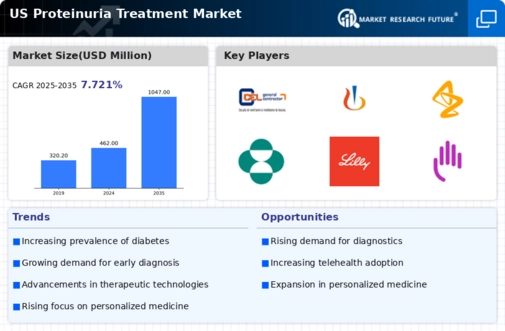Growing Geriatric Population
The increasing geriatric population in the US is a notable driver for the proteinuria treatment market. As individuals age, the risk of developing kidney-related issues, including proteinuria, tends to rise. The US Census Bureau projects that by 2030, approximately 20% of the population will be aged 65 and older. This demographic shift is likely to lead to a higher incidence of chronic kidney disease and related conditions, thereby increasing the demand for effective proteinuria treatments. The proteinuria treatment market must adapt to this growing need by developing age-appropriate therapies and management strategies. Additionally, healthcare systems will need to focus on providing comprehensive care for the elderly, which could further stimulate market growth.
Increasing Awareness of Kidney Health
The growing awareness surrounding kidney health is a pivotal driver for the proteinuria treatment market. Educational campaigns and initiatives by healthcare organizations have led to heightened public understanding of kidney diseases, including proteinuria. This increased awareness is likely to result in more individuals seeking medical advice and testing for kidney-related issues. As a consequence, the demand for effective treatments is expected to rise. In the US, the National Kidney Foundation has reported that approximately 37 million adults are affected by chronic kidney disease, which underscores the urgency for effective proteinuria treatments. The proteinuria treatment market is thus positioned to benefit from this trend, as healthcare providers and patients alike prioritize kidney health and early intervention.
Regulatory Support for Innovative Therapies
Regulatory support for innovative therapies is emerging as a significant driver in the proteinuria treatment market. The US Food and Drug Administration (FDA) has been actively promoting the development of new treatments through expedited review processes and incentives for breakthrough therapies. This regulatory environment encourages pharmaceutical companies to invest in research and development for novel proteinuria treatments. As a result, the proteinuria treatment market is likely to witness an influx of new products aimed at improving patient outcomes. The potential for faster market entry of innovative therapies could enhance competition and drive down costs, ultimately benefiting patients and healthcare providers alike. This supportive regulatory landscape is crucial for fostering advancements in the treatment of proteinuria.
Rising Prevalence of Diabetes and Hypertension
The escalating prevalence of diabetes and hypertension in the US is a critical driver for the proteinuria treatment market. Both conditions are known risk factors for kidney damage and are closely associated with the development of proteinuria. According to the Centers for Disease Control and Prevention (CDC), nearly 34.2 million Americans have diabetes, while about 45% of adults have hypertension. This alarming trend suggests a growing patient population that may require effective proteinuria management solutions. The proteinuria treatment market is likely to expand as healthcare providers focus on addressing the complications arising from these chronic conditions. Consequently, the demand for targeted therapies and comprehensive management strategies is expected to increase, further propelling market growth.
Technological Innovations in Treatment Options
Technological advancements in treatment options are significantly influencing the proteinuria treatment market. Innovations such as novel pharmacological agents and improved delivery systems are enhancing the efficacy of treatments available for proteinuria. For instance, recent developments in angiotensin receptor blockers (ARBs) and sodium-glucose cotransporter 2 (SGLT2) inhibitors have shown promising results in managing proteinuria. The proteinuria treatment market is likely to experience growth as these advanced therapies become more widely adopted. Furthermore, the integration of telemedicine and digital health solutions is facilitating better patient management and adherence to treatment regimens, which could further drive market expansion. As the US healthcare system increasingly embraces these technologies, the proteinuria treatment market is poised for significant evolution.

















Leave a Comment